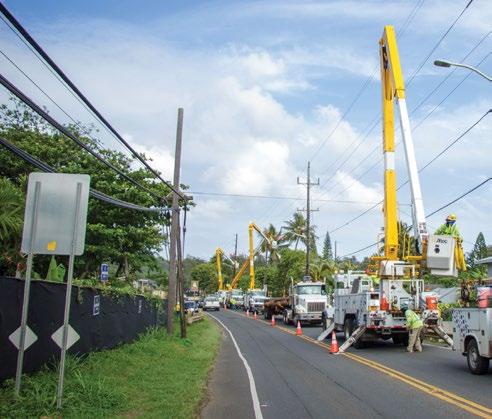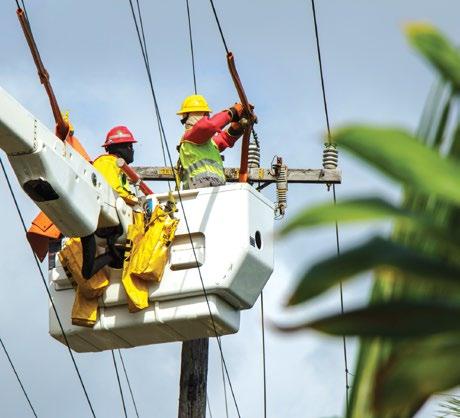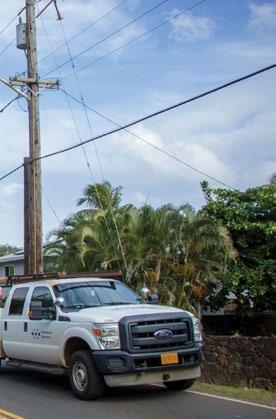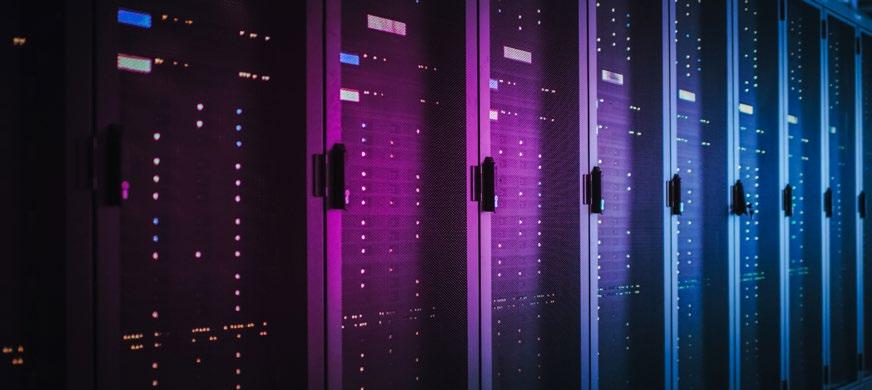
6 minute read
Reliability & Resilience

Reliability and Resilience
Advertisement
3 7
We know the important role electricity plays in the lives of our customers and communities. From ensuring businesses and essential services can operate effectively, to providing comfort at home during the hottest of days, we work to provide power when it’s needed. We are constantly looking for ways to improve and strengthen our grid to deliver the reliability our customers expect, prepare for severe weather and other events, recover from any disruptions quickly and safely and minimize impacts to our customers.
Managing Reliability and Resilience
As an island utility, we’re not connected to a large system of interconnected generation facilities like U.S. mainland utilities, nor are our individual islands interconnected. This means each island must independently provide high levels of reliability, and we must plan carefully to ensure resilience.
We continually maintain and upgrade our transmission and distribution system to ensure seamless delivery of power to our customers. Day-to-day maintenance is a key part of keeping the grid resilient. We regularly inspect our poles, lines, and other equipment, and work to replace and upgrade aging and faulty equipment before failures happen. We regularly trim the vegetation around our equipment, as many power outages during high winds and storms are due to tree branches or other vegetation falling onto power lines. We’re working to reduce the impact of outages by adding devices to section off parts of the grid to reduce the number of customers affected by an outage. We have also completed distribution protection studies for each of the five islands we serve. We measure and report reliability performance using metrics commonly used in the electric utility industry regarding the duration and frequency of power interruptions for customers. Both the company and executives have financial incentives to promote strong reliability performance.
Ensuring Grid Reliability
As we work to build a more resilient grid and add more variable generation such as solar and wind, it’s critical that we maintain grid reliability and stability. The displacement of “firm” thermal generation requires that we obtain new, non-traditional grid resources - such as solutions to provide limited duration capacity and fast frequency response - to maintain system stability. We’re in the process of acquiring these grid services (29 MW on O‘ahu, 7 MW on Maui and 6 MW on Hawai‘i Island).
In addition, battery storage can provide rapid response to unexpected events such as a sudden drop in energy production, improving reliability and reducing likelihood of outages. Our proposed 12-MW battery energy storage system (BESS) at Keāhole on Hawai‘i Island was among several projects selected under the renewable RFP procurement process. On O‘ahu, a proposed 185-MW IPP BESS project will provide 50 MW of fast frequency response, while on Maui, our proposed Waena BESS project will add 40 MW of capacity. If approved by the PUC, these projects could be operational between 2022 and 2023.

Handbook For
Emergency Preparedness
Be prepared Be informed
Read our Handbook for Emergency Preparedness
Hardening Our Grid
We are focused on ensuring the resilience of our system. Our efforts include:
Using advanced climate risk modeling to assess risks and inform our planning process
Deploying advanced meters and other technologies that allow us to respond more quickly to system interruptions
Exploring the use of damage prediction modeling to estimate damage from severe natural event scenarios in order to support planning and response
Evaluating new construction standards for new or replaced wood distribution poles
Exploring use of community microgrids and/or critical customer clusters to be able to quickly restore power to critical customers
Building more modern and efficient power plants inland, away from the coastline. An example is the Schofield Generating Station, which was completed and brought online in 2018. The biofuel-capable generating facility is located on military property inland at a higher elevation. It can be isolated to serve the military base and other critical facilities in the event of an emergency, and feeds electricity to the grid that serves all O‘ahu customers the rest of the time.
Collaborating with key partners, such as the military, to supply energy to customers during an emergency
Engaging with stakeholders to incorporate resilience needs and priorities through our
Integrated Grid Planning process
Emergency Preparedness
Being located in the middle of the Pacific Ocean means being prepared for disasters is crucial to limit damage and hasten recovery.
We work closely with state emergency management officials and county agencies to develop disaster plans and practice disaster response. Our employees are trained to utilize FEMA’s Incident Command System as a structure for disaster response and recovery. Our Electrical Service Restoration, Cyber & Physical Security and COVID-19 Pandemic Emergency Management plans detail recovery activities for specific situations.
We maintain strong relationships with other utilities, transportation companies and contractors — both locally and nationally — to help speed recovery. We’re also a member of the Western Region Mutual Aid Group, which enables us to gain insight into best practices. These partnerships help us secure labor and/or material resources in the event of a disaster.
Our Electrical Service Restoration Plan (ESRP) outlines processes to prepare for and respond to emergencies, such as earthquakes, flooding, hurricanes and volcanic eruptions, so we can restore service to customers safely and efficiently. We conduct ESRP training annually, including practicing emergency scenarios through drills and tabletop exercises.
Where a potential outage incident is identifiable ahead of time, we inform employees, customers, mutual aid partners, and other stakeholders in advance, advise them on our preparations, and share ways customers can prepare, using a range of communications tools, including media outreach, online and social media and other means.
We have publicly disclosed our emergency outage and response times since 2015. Our emergency response time metric measures the average time it takes to respond to an emergency event, such as energized lines down, downed poles or motor vehicle accidents involving utility equipment that result in lane closures.
Our Handbook for Emergency Preparedness is designed to help customers plan for emergencies. It is available in several languages and provides information on emergency supplies, evacuation plans and how to minimize inconveniences and dangers in emergencies.
Promoting Community Resilience
We have led a series of community resilience-based workshops for the Ko‘olaupoko region of O‘ahu, a community that receives all of its electricity from transmission lines that cross the Ko‘olau mountain range and is thus vulnerable to outages in the event of a major disaster. The workshops drew community and government leaders together in a collaborative process to identify actions to strengthen the region’s resilience. For more details on the Ko‘olaupoko Community Resilience Initiative, see page 67.
Secure Digitalization
4
Cybersecurity is consistently recognized as one of the top risks facing the electric utility industry. As digitalization of our economy increases, ensuring cybersecurity of our system and customer data is of increasing importance. We apply a disciplined risk management approach based on industry standards and best practices, prioritizing our investments and resources to protect our most critical assets and sensitive data.
We engage with local, state, and federal agencies, utility peers and experts to share threat information and best practices, perform tests and assessments and conduct cybersecurity exercises. We also participate in mutual assistance programs including the Cyber Mutual Assistance Program, the Cybersecurity Risk Information Sharing Program and the Electricity Information Sharing and Analysis Center. Our customer and community outreach efforts include awareness campaigns via television, radio, and social media. Internally, we promote a strong cybersecurity culture through email phishing tests, cyber awareness campaigns and annual training.
We continue to strengthen our protection and detection capabilities across people, processes and technology to defend our networks, our customers and our grid. The enterprise cybersecurity program prescribes a comprehensive set of management, operational and technical controls aligned to an industry-standard framework and tailored to address our unique risk profile. Controls are continuously monitored for effectiveness, with tracking of key performance indicators. These metrics are presented to the Board of Directors and the Board Audit and Risk Committee each quarter.











